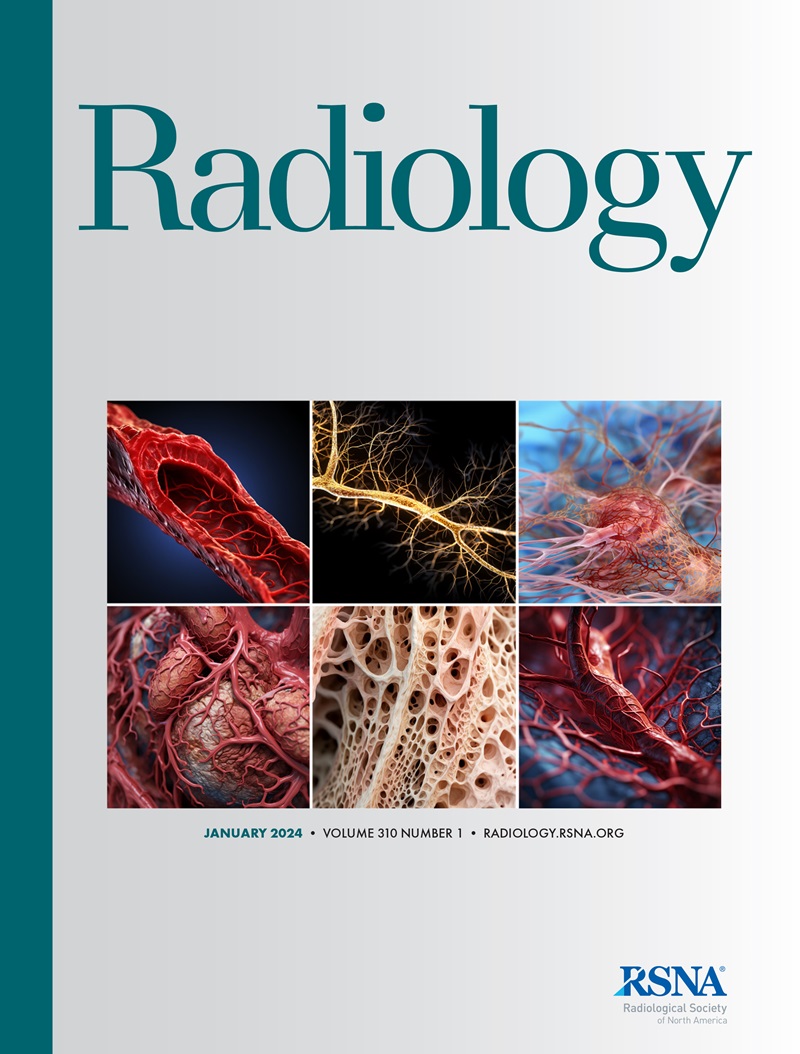Adaptive Breast MRI Scanning Using AI.
IF 12.1
1区 医学
Q1 RADIOLOGY, NUCLEAR MEDICINE & MEDICAL IMAGING
Sarah Eskreis-Winkler, Arka Bhowmik, Lori H Kelly, Roberto Lo Gullo, Donna D'Alessio, Kristin Belen, Molly P Hogan, Nicole B Saphier, Varadan Sevilimedu, Janice S Sung, Christopher E Comstock, Elizabeth J Sutton, Katja Pinker
下载PDF
{"title":"Adaptive Breast MRI Scanning Using AI.","authors":"Sarah Eskreis-Winkler, Arka Bhowmik, Lori H Kelly, Roberto Lo Gullo, Donna D'Alessio, Kristin Belen, Molly P Hogan, Nicole B Saphier, Varadan Sevilimedu, Janice S Sung, Christopher E Comstock, Elizabeth J Sutton, Katja Pinker","doi":"10.1148/radiol.242924","DOIUrl":null,"url":null,"abstract":"<p><p>Background MRI protocols typically involve many imaging sequences and often require too much time. Purpose To simulate artificial intelligence (AI)-directed stratified scanning for screening breast MRI with various triage thresholds and evaluate its diagnostic performance against that of the full breast MRI protocol. Materials and Methods This retrospective reader study included consecutive contrast-enhanced screening breast MRI examinations performed between January 2013 and January 2019 at three regional cancer sites. In this simulation study, an in-house AI tool generated a suspicion score for subtraction maximum intensity projection images during a given MRI examination, and the score was used to determine whether to proceed with the full MRI protocol or end the examination early (abbreviated breast MRI [AB-MRI] protocol). Examinations with suspicion scores under the 50th percentile were read using both the AB-MRI protocol (ie, dynamic contrast-enhanced MRI scans only) and the full MRI protocol. Diagnostic performance metrics for screening with various AI triage thresholds were compared with those for screening without AI triage. Results Of 863 women (mean age, 52 years ± 10 [SD]; 1423 MRI examinations), 51 received a cancer diagnosis within 12 months of screening. The diagnostic performance metrics for AI-directed stratified scanning that triaged 50% of examinations to AB-MRI versus full MRI protocol scanning were as follows: sensitivity, 88.2% (45 of 51; 95% CI: 79.4, 97.1) versus 86.3% (44 of 51; 95% CI: 76.8, 95.7); specificity, 80.8% (1108 of 1372; 95% CI: 78.7, 82.8) versus 81.4% (1117 of 1372; 95% CI: 79.4, 83.5); positive predictive value 3 (ie, percent of biopsies yielding cancer), 23.6% (43 of 182; 95% CI: 17.5, 29.8) versus 24.7% (42 of 170; 95% CI: 18.2, 31.2); cancer detection rate (per 1000 examinations), 31.6 (95% CI: 22.5, 40.7) versus 30.9 (95% CI: 21.9, 39.9); and interval cancer rate (per 1000 examinations), 4.2 (95% CI: 0.9, 7.6) versus 4.9 (95% CI: 1.3, 8.6). Specificity decreased by no more than 2.7 percentage points with AI triage. There were no AI-triaged examinations for which conducting the full MRI protocol would have resulted in additional cancer detection. Conclusion AI-directed stratified MRI decreased simulated scan times while maintaining diagnostic performance. © RSNA, 2025 <i>Supplemental material is available for this article.</i> See also the editorial by Strand in this issue.</p>","PeriodicalId":20896,"journal":{"name":"Radiology","volume":"315 3","pages":"e242924"},"PeriodicalIF":12.1000,"publicationDate":"2025-06-01","publicationTypes":"Journal Article","fieldsOfStudy":null,"isOpenAccess":false,"openAccessPdf":"https://www.ncbi.nlm.nih.gov/pmc/articles/PMC12207643/pdf/","citationCount":"0","resultStr":null,"platform":"Semanticscholar","paperid":null,"PeriodicalName":"Radiology","FirstCategoryId":"3","ListUrlMain":"https://doi.org/10.1148/radiol.242924","RegionNum":1,"RegionCategory":"医学","ArticlePicture":[],"TitleCN":null,"AbstractTextCN":null,"PMCID":null,"EPubDate":"","PubModel":"","JCR":"Q1","JCRName":"RADIOLOGY, NUCLEAR MEDICINE & MEDICAL IMAGING","Score":null,"Total":0}
引用次数: 0
引用
批量引用
Abstract
Background MRI protocols typically involve many imaging sequences and often require too much time. Purpose To simulate artificial intelligence (AI)-directed stratified scanning for screening breast MRI with various triage thresholds and evaluate its diagnostic performance against that of the full breast MRI protocol. Materials and Methods This retrospective reader study included consecutive contrast-enhanced screening breast MRI examinations performed between January 2013 and January 2019 at three regional cancer sites. In this simulation study, an in-house AI tool generated a suspicion score for subtraction maximum intensity projection images during a given MRI examination, and the score was used to determine whether to proceed with the full MRI protocol or end the examination early (abbreviated breast MRI [AB-MRI] protocol). Examinations with suspicion scores under the 50th percentile were read using both the AB-MRI protocol (ie, dynamic contrast-enhanced MRI scans only) and the full MRI protocol. Diagnostic performance metrics for screening with various AI triage thresholds were compared with those for screening without AI triage. Results Of 863 women (mean age, 52 years ± 10 [SD]; 1423 MRI examinations), 51 received a cancer diagnosis within 12 months of screening. The diagnostic performance metrics for AI-directed stratified scanning that triaged 50% of examinations to AB-MRI versus full MRI protocol scanning were as follows: sensitivity, 88.2% (45 of 51; 95% CI: 79.4, 97.1) versus 86.3% (44 of 51; 95% CI: 76.8, 95.7); specificity, 80.8% (1108 of 1372; 95% CI: 78.7, 82.8) versus 81.4% (1117 of 1372; 95% CI: 79.4, 83.5); positive predictive value 3 (ie, percent of biopsies yielding cancer), 23.6% (43 of 182; 95% CI: 17.5, 29.8) versus 24.7% (42 of 170; 95% CI: 18.2, 31.2); cancer detection rate (per 1000 examinations), 31.6 (95% CI: 22.5, 40.7) versus 30.9 (95% CI: 21.9, 39.9); and interval cancer rate (per 1000 examinations), 4.2 (95% CI: 0.9, 7.6) versus 4.9 (95% CI: 1.3, 8.6). Specificity decreased by no more than 2.7 percentage points with AI triage. There were no AI-triaged examinations for which conducting the full MRI protocol would have resulted in additional cancer detection. Conclusion AI-directed stratified MRI decreased simulated scan times while maintaining diagnostic performance. © RSNA, 2025 Supplemental material is available for this article. See also the editorial by Strand in this issue.
人工智能自适应乳房MRI扫描。
磁共振成像方案通常涉及许多成像序列,通常需要太多的时间。目的模拟人工智能(AI)定向分层扫描筛查乳腺MRI的不同分类阈值,并评估其与全乳腺MRI方案的诊断性能。材料和方法本回顾性读者研究包括2013年1月至2019年1月期间在三个区域性癌症部位进行的连续对比增强筛查乳腺MRI检查。在这项模拟研究中,一个内部人工智能工具在给定的MRI检查中为减除最大强度投影图像生成怀疑评分,并使用该评分来确定是继续进行完整的MRI方案还是提前结束检查(缩写乳腺MRI [AB-MRI]方案)。可疑分数低于50百分位的检查同时使用AB-MRI方案(即仅动态对比增强MRI扫描)和完整的MRI方案进行阅读。将具有各种人工智能分类阈值的筛查的诊断性能指标与没有人工智能分类的筛查进行比较。结果863例女性(平均年龄52岁±10岁);1423例MRI检查),51例在12个月内被诊断为癌症。人工智能定向分层扫描的诊断性能指标(将50%的检查分类为AB-MRI与全MRI方案扫描)如下:敏感性为88.2% (45 / 51;95% CI: 79.4, 97.1) vs . 86.3% (44 / 51;95% ci: 76.8, 95.7);特异性:80.8% (1108 / 1372;95% CI: 78.7, 82.8) vs . 81.4% (1117 / 1372;95% ci: 79.4, 83.5);阳性预测值3(即活检结果为癌症的百分比),23.6%(182例中有43例;95% CI: 17.5, 29.8)对24.7% (42 / 170;95% ci: 18.2, 31.2);癌症检出率(每1000次检查),31.6 (95% CI: 22.5, 40.7)对30.9 (95% CI: 21.9, 39.9);间隔期癌症发病率(每1000次检查),4.2 (95% CI: 0.9, 7.6) vs 4.9 (95% CI: 1.3, 8.6)。人工智能分类的特异性下降不超过2.7个百分点。没有人工智能分类检查,进行完整的MRI协议会导致额外的癌症检测。结论人工智能定向分层MRI在保持诊断性能的同时减少了模拟扫描次数。©RSNA, 2025本文可获得补充材料。参见本期《Strand》的社论。
本文章由计算机程序翻译,如有差异,请以英文原文为准。

 求助内容:
求助内容: 应助结果提醒方式:
应助结果提醒方式:


